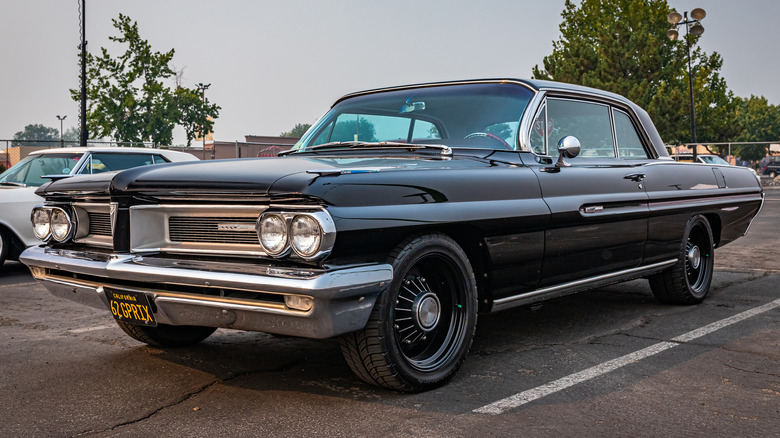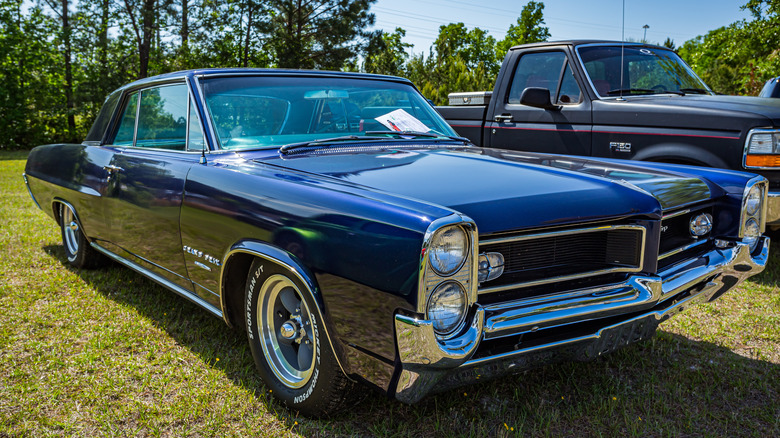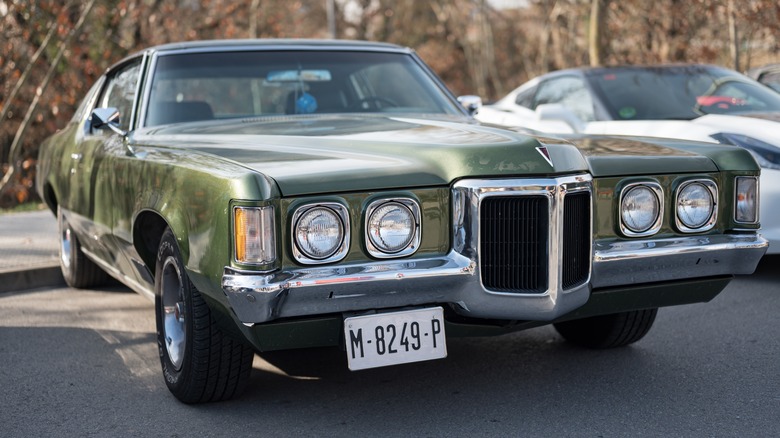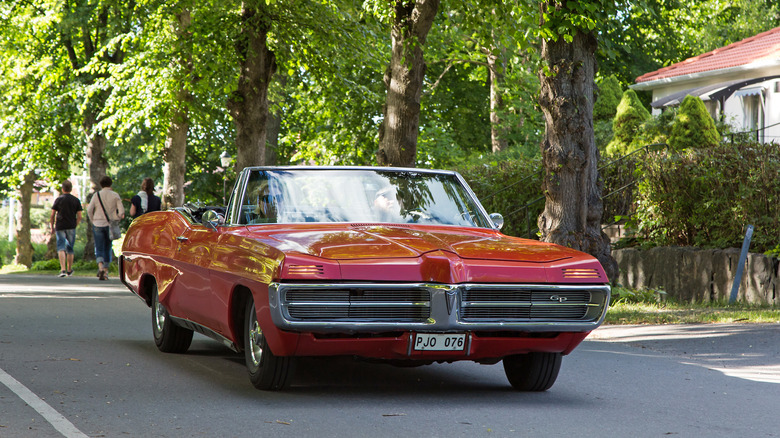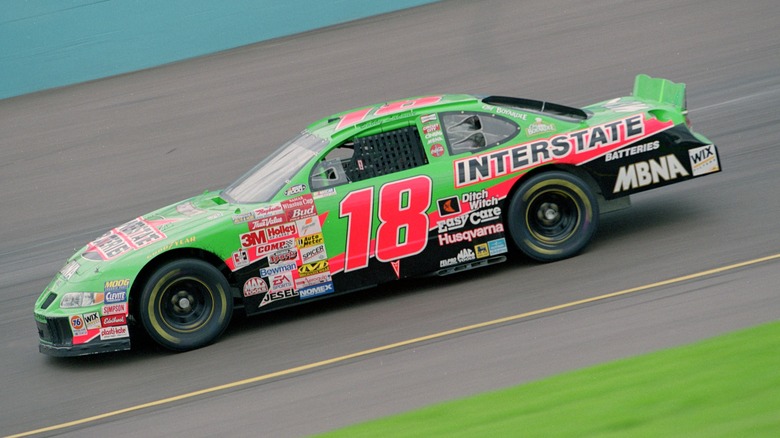4 Facts About The Pontiac Grand Prix Probably Only Hardcore Car Fans Know
When contemplating the auto industry's longest-running nameplates, the Jeep CJ-5 and CJ-7 likely spring to mind, as might the Chevy Suburban, which has been around for 12 generations and ranks as the oldest continually produced vehicle in the world. It might take you a while to get to the Pontiac Grand Prix, but that badge had a 47-year run after its introduction in 1962. It was in continuous production through 2008 and over that time evolved from a full-sized luxury coupe to a smaller, sportier model.
The Grand Prix's name was borrowed from the French term that is commonly used to label international races on the Formula 1 Circuit and translates to "Big Prize." The model was a big prize indeed for Pontiac's accountants, with total sales of more than four million units over its nearly half-century run. The best year for the model was 1977, with over 288,000 leaving dealer lots. Like any car with such a long history, the Grand Prix has some relatively obscure lore hiding in its back seat.
It was originally called the Ventura
1962 was a big year for Pontiac. It sold 521,933 cars that year, its second-best year ever to date behind 1955. The 75 millionth Pontiac also rolled off the line that Spring; a Bonneville convertible. Two new models joined the lineup as well. The LeMans, which evolved into the GTO in 1964, made its first appearance, as did the Grand Prix, a coupe version of the Catalina with a refined interior.
It was initially going to be called the Ventura, but Pontiac made a last-minute lane change and assigned that name to the Catalina's top trim level instead. The Grand Prix and Catalina shared GM's B-body platform, and Grand Prix buyers could initially choose between 389 and 421 cubic inch V8s. Maximum output on the larger engine was 370 horsepower and 460 lb-ft of torque. The 1964 Grand Prix shown above had a base price of $3,499 (about $35,000 today), but options could push that past $5,000.
There were eight generations of the Grand Prix
The 1964 model year marked the end of the model's first generation, and the original engine choices were carried over to the second and replaced in 1967 by 400 and 428 cubic inch versions. For the third generation that appeared in 1969, the Grand Prix moved to the mid-sized G-body platform it shared with the Chevy Monte Carlo and Malibu, Buick Regal and Century, and Oldsmobile Cutlass. Further generational updates and platform shifts came in 1973 and 1978, and a 3.8-liter V6 became the first non-V8 Grand Prix powerplant in 1980. A 350 cubic inch (5.7 liter) diesel engine was added the following year, but that required a ridiculous 16.5 seconds to get the Grand Prix to 60 miles per hour from a standstill.
Fuel injection appeared for the first time on the Grand Prix's 4.3-liter V6 in 1987, the same year the model moved to the front-wheel drive W platform. The last two major updates came in 1997 and 2004, bringing along more powerful engine choices. The supercharged 3.8-liter V6 could produce 260 horsepower, and a 5.3L V8 that generated 303 horsepower and 323 lb-ft of torque was made available in 2005. The Grand Prix only lived three more years, though, as Pontiac was dumped by GM in 2009 as part of its bankruptcy reorganization.
The Grand Prix convertible was only made in 1967
The Grand Prix was available as a coupe from its birth through 2002, and in 1990 a sedan version was added. The anomalous year was 1967, the only time a convertible version of the Grand Prix was produced. Despite its gorgeous, sweeping lines and vast open-air cruising deck, the Grand Prix convertible was not a hot commodity. The 5,856 convertibles Pontiac made that year were dwarfed by the 37,000-plus hardtop coupes that left the assembly line. You might think that rarity would have made the original base price of $3,813 for a convertible (about $36,000 today) a good investment, but you'd be wrong.
Of the 36 1967 convertibles that have hit the market in the last five years, only two have sold for above the $36,000 mark. The most valuable was a Hurst edition powered by a 455 cubic inch V8 that sold three times in the past ten years for an average of more than $100,000. More typical are the dozens that changed hands for between roughly $13,000 and $40,000. The most intriguing Grand Prix convertible in existence is a burgundy specimen that resides in the Smithsonian's National Museum of American History, with a catalog number of 1999.0328.01. It was donated in 1999 by Siewchin Yong Sommer, who traveled with her husband Guenther to 49 states and 251 national parks over the course of 32 years, during which they put 150,000 miles on the car's 428-inch V8.
It was a repeat NASCAR champion
The Grand Prix was popular as a mass-market car, but it was also a success on the racetrack. NASCAR champions who have driven Grand Prix stock cars include Dale Earnhardt, Rusty Wallace, Bobby Labonte, Tony Stewart, and Richard Petty. Wallace, Stewart, and Labonte all piloted a Grand Prix during championship years. Earnhardt's Grand Prix ride came in 1981, when he was 29 and the defending series champion. He began the season driving for Osterlund Racing, but team owner Rod Osterlund sold the operation in June to Kentucky coal magnate J.D. Stacy, who promptly fired several of his star driver's close friends. Earnhardt ran four races for Stacy before jumping to Richard Childress Racing, which was not yet ready to compete for championships. He finished seventh in the standings that year, left for Bud Moore's team for two seasons, then returned to win six championships for Childress while driving Chevrolets.
Petty began driving Pontiacs in 1982, and won his record 200th Cup series race in a Grand Prix at the 1984 Firecracker 400 at Daytona, before hopping back in a Grand Prix in 1986 and 1987. Although he was coasting to the end of his career, Petty logged 25 top ten finishes over those two seasons. Joe Gibbs Racing later saw tremendous success with Grand Prix models in the early aughts. Labonte won the Cup championship in 2000 in his No. 18 Grand Prix, and his teammate Tony Stewart drove his No. 20 Grand Prix to the title two years later.
